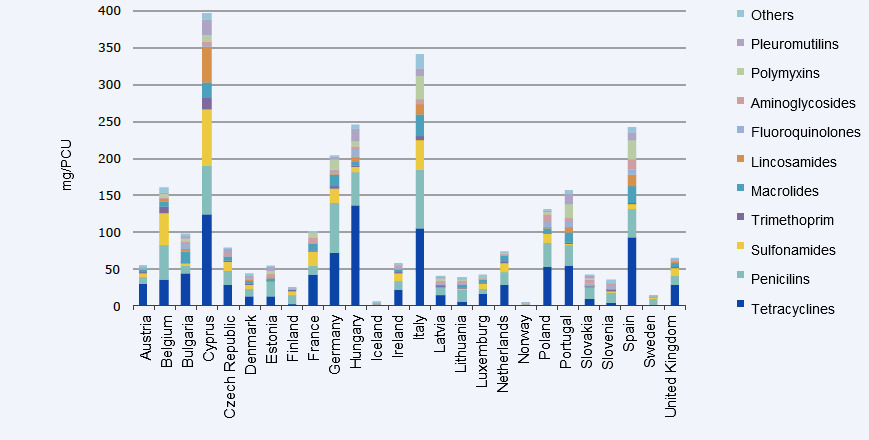Paper
Hanne Bak and Poul Henning Rathkjen: Reduced use of antimicrobials after vaccination of pigs against porcine proliferative enteropathy in a Danish SPF herd. Acta Veterinaria Scandinavica 2009, 51:1

What are they studying?
The present study investigated the impact of vaccination against ileitis or proliferative enteropathy (PE) caused by Lawsonia intracellularis on the use of group medication with antibiotics. In contrast to other studies that had demonstrated a reduced use of antibiotics in vaccinated pigs, this study was conducted under conditions associated to the Danish farming system, with a low baseline level of antibiotic treatment. In addition to group medication, production performance was compared between vaccinated and non-vaccinated pigs.
How is it done?
The study was conducted on a 650-sow specific pathogen free (SPF) herd producing batches of about 1,000 pigs in a 3-week system. In total, 1,556 pigs from 16 consecutive batches were included. A modified parallel group design was used, with every second batch of pigs being vaccinated between 4 and 5 weeks of age with a live oral L. intracellularis vaccine via drinking water. Seven thousand nine hundred pigs from 8 batches were vaccinated,whereas 7756 pigs from the other 8 batches served as non-vaccinated controls. Group medications were categorized based on farm history and diagnostic investigation into treatment against weaning diarrhoea (mainly caused by E. coli) and treatment later than 3 weeks after weaning, usually against PE.
To evaluate production performance, number of days from weaning to slaughter, carcass weight and average daily weight gain (ADWG) were recorded.
What are the results?
Significantly less pigs in the batches vaccinated against Ileitis needed group treatment with antibiotics. Only some pens from one vaccinated batch needed diarrhoea treatment with oxytetracycline later than 3 weeks post-weaning. In contrast, nearly all the pigs in three batches of the non-vaccinated group needed group treatment against PE. Overall, consumption of oxytetracycline was reduced by 79% in the vaccinated group. On top of that, analysis of the available slaughterhouse data showed improved performance in the vaccinated group, with an ADWG increase of 46 g/day, a 2-day shorter weaning-to-slaughter period, and a 1.25-kg higher carcass weight.
What implications does this paper have?
The need for reducing the use of antibiotics is evident globally. At the time of the study, public pressure on the use of antibiotics was particularly strong in Northern Europe. Since then it has expanded across the world, and antibiotic use in food producing animals is nowadays under scrutiny around the globe, including Asia and the Americas. This paper demonstrates that implementing preventative vaccination against Ileitis is one option to help reducing the need for antibiotic treatment. The reduction was achieved despite the low baseline level of antibiotic consumption. The improvement in production performance in the vaccinated batches compared to the non-vaccinated pigs, which were treated when clinical signs occurred, suggests that: Even in periods when clinical signs are not obvious L. intracellularis might cause mild, subclinical or chronic lesions and can negatively affect pig performance. An old saying seems to apply here again: Prevention is better than cure.
|
Vaccination against ileitis has not been implemented in all countries equally. Obviously, many explanations may justify these differences. The most common reason for not vaccinating has probably been economic: vaccination is more expensive than treatment. Another justification may be related to the production structure, that differs in every country. In those countries where vertically integrated pig companies are the rule and legislation allows it, collective treatments in the feed are prioritized vs. individual treatments or farm treatments —such as medication/vaccination in drinking water. However, in those countries where a strict control on the use of antibiotics, their prescription by Veterinarians and their consumption by livestock has already been implemented (see, for example, what happens in Denmark or the Netherlands), the use of the vaccine allows control of the disease without increasing the amount of antibiotics dispensed. This last reason might be the main one in the European Union in the not too distant future. In the coming years, the use of antimicrobials will be more closely regulated, following the guidelines set by the WHO in its global report on antimicrobial resistance in 2014. As is becoming increasingly common in the European Union, these restrictions will be more severe, possibly with controls on quantities dispensed, in the style of Holland or Denmark. Given this perspective, it is clear that decisions will be based not only on the effectiveness or the cost of treatment, but also on the need to reduce the amount of antibiotics dispensed. The article perfectly illustrates this trend by providing an additional advantage to the efficacy data typically associated with the use of the vaccine against L. intracellularis.
Sales for livestock (including horses) in mg/PCU (European Medicines Agency report 15/10/2013 "Sales of veterinary antimicrobial agents in 25 EU / EEA countries in 2011.") |





